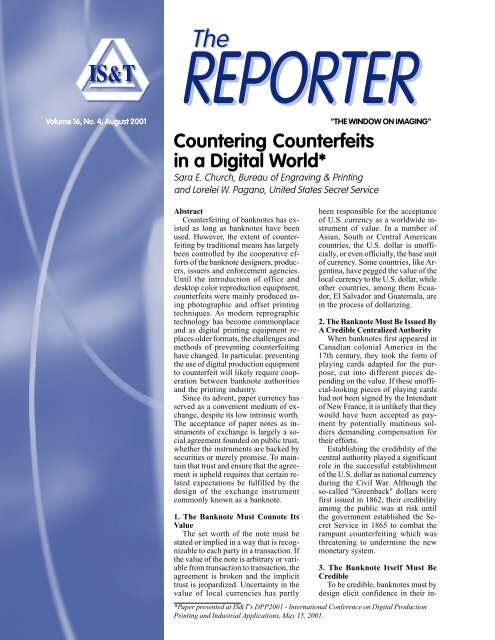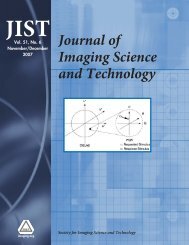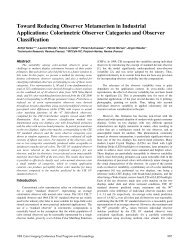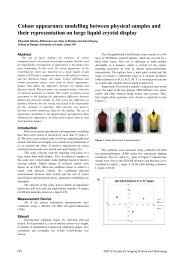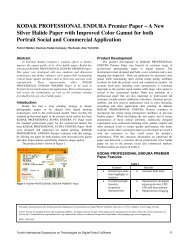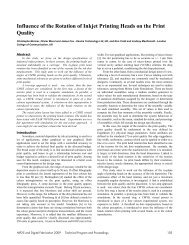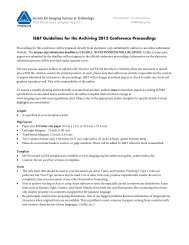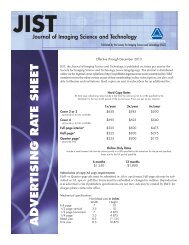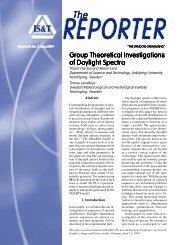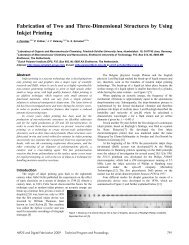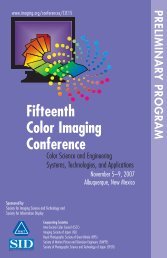Issue 4, August 2001 - Society for Imaging Science and Technology
Issue 4, August 2001 - Society for Imaging Science and Technology
Issue 4, August 2001 - Society for Imaging Science and Technology
Create successful ePaper yourself
Turn your PDF publications into a flip-book with our unique Google optimized e-Paper software.
The<br />
REPORTER<br />
Volume 16, No. 4, <strong>August</strong> <strong>2001</strong><br />
"THE WINDOW ON IMAGING"<br />
Countering Counterfeits<br />
in a Digital World*<br />
Sara E. Church, Bureau of Engraving & Printing<br />
<strong>and</strong> Lorelei W. Pagano, United States Secret Service<br />
Abstract<br />
Counterfeiting of banknotes has existed<br />
as long as banknotes have been<br />
used. However, the extent of counterfeiting<br />
by traditional means has largely<br />
been controlled by the cooperative ef<strong>for</strong>ts<br />
of the banknote designers, producers,<br />
issuers <strong>and</strong> en<strong>for</strong>cement agencies.<br />
Until the introduction of office <strong>and</strong><br />
desktop color reproduction equipment,<br />
counterfeits were mainly produced using<br />
photographic <strong>and</strong> offset printing<br />
techniques. As modern reprographic<br />
technology has become commonplace<br />
<strong>and</strong> as digital printing equipment replaces<br />
older <strong>for</strong>mats, the challenges <strong>and</strong><br />
methods of preventing counterfeiting<br />
have changed. In particular, preventing<br />
the use of digital production equipment<br />
to counterfeit will likely require cooperation<br />
between banknote authorities<br />
<strong>and</strong> the printing industry.<br />
Since its advent, paper currency has<br />
served as a convenient medium of exchange,<br />
despite its low intrinsic worth.<br />
The acceptance of paper notes as instruments<br />
of exchange is largely a social<br />
agreement founded on public trust,<br />
whether the instruments are backed by<br />
securities or merely promise. To maintain<br />
that trust <strong>and</strong> ensure that the agreement<br />
is upheld requires that certain related<br />
expectations be fulfilled by the<br />
design of the exchange instrument<br />
commonly known as a banknote.<br />
1. The Banknote Must Connote Its<br />
Value<br />
The set worth of the note must be<br />
stated or implied in a way that is recognizable<br />
to each party in a transaction. If<br />
the value of the note is arbitrary or variable<br />
from transaction to transaction, the<br />
agreement is broken <strong>and</strong> the implicit<br />
trust is jeopardized. Uncertainty in the<br />
value of local currencies has partly<br />
been responsible <strong>for</strong> the acceptance<br />
of U.S. currency as a worldwide instrument<br />
of value. In a number of<br />
Asian, South or Central American<br />
countries, the U.S. dollar is unofficially,<br />
or even officially, the base unit<br />
of currency. Some countries, like Argentina,<br />
have pegged the value of the<br />
local currency to the U.S. dollar, while<br />
other countries, among them Ecuador,<br />
El Salvador <strong>and</strong> Guatemala, are<br />
in the process of dollarizing.<br />
2. The Banknote Must Be <strong>Issue</strong>d By<br />
A Credible Centralized Authority<br />
When banknotes first appeared in<br />
Canadian colonial America in the<br />
17th century, they took the <strong>for</strong>m of<br />
playing cards adapted <strong>for</strong> the purpose,<br />
cut into different pieces depending<br />
on the value. If these unofficial-looking<br />
pieces of playing cards<br />
had not been signed by the Intendant<br />
of New France, it is unlikely that they<br />
would have been accepted as payment<br />
by potentially mutinous soldiers<br />
dem<strong>and</strong>ing compensation <strong>for</strong><br />
their ef<strong>for</strong>ts.<br />
Establishing the credibility of the<br />
central authority played a significant<br />
role in the successful establishment<br />
of the U.S. dollar as national currency<br />
during the Civil War. Although the<br />
so-called "Greenback" dollars were<br />
first issued in 1862, their credibility<br />
among the public was at risk until<br />
the government established the Secret<br />
Service in 1865 to combat the<br />
rampant counterfeiting which was<br />
threatening to undermine the new<br />
monetary system.<br />
3. The Banknote Itself Must Be<br />
Credible<br />
To be credible, banknotes must by<br />
design elicit confidence in their in-<br />
*Paper presented at IS&T's DPP<strong>2001</strong> - International Conference on Digital Production<br />
Printing <strong>and</strong> Industrial Applications, May 15, <strong>2001</strong>.
IS&T — The <strong>Society</strong> <strong>for</strong> <strong>Imaging</strong> <strong>Science</strong> <strong>and</strong> <strong>Technology</strong><br />
tegrity <strong>and</strong> authenticity. They must<br />
have features <strong>and</strong> characteristics that<br />
distinguish them from the attempted<br />
duplication, simulation or counterfeiting<br />
so that the public, as well as<br />
the banknote authorities <strong>and</strong> experts<br />
can tell they are in possession of the<br />
genuine article. Additionally, counterfeiting<br />
must be contained in order<br />
to maintain confidence in the<br />
banknote system. Prior to the U.S.<br />
Civil War, banknotes were issued by<br />
state-chartered banks. As many as<br />
1600 different styles of notes were in<br />
circulation at the time. Counterfeiting<br />
was prevalent, <strong>and</strong> with so many<br />
varieties of genuine notes, knowing<br />
what each type was supposed to look<br />
like was an onerous task. This situation<br />
gave rise to the compilation <strong>and</strong><br />
marketing of large descriptive counterfeit<br />
detection manuals, which described<br />
in detail genuine notes <strong>and</strong><br />
every known variety of the corresponding<br />
counterfeit. As new notes<br />
emerged, genuine <strong>and</strong> counterfeit,<br />
these manuals had to be updated.<br />
However, once the authority to issue<br />
currency was taken over by the U.S.<br />
Department of the Treasury, <strong>and</strong> the<br />
Secret Service was established to investigate<br />
<strong>and</strong> suppress counterfeiting,<br />
currency designs became more<br />
st<strong>and</strong>ard <strong>and</strong> counterfeiting was<br />
brought into check.<br />
Today, the dollar is backed by U.S.<br />
Treasury securities, which earn interest<br />
as long as the notes remain in circulation.<br />
Last year, the $540 billion<br />
of U.S. currency in circulation worldwide<br />
produced $26 billion in interest,<br />
a substantial contribution to the<br />
credibility of the U.S. dollar as a<br />
stable currency.<br />
Banknote Authorities<br />
Typically, a number of specific<br />
functions help to maintain a circulating<br />
supply of paper currency:<br />
Design <strong>and</strong> Production<br />
Issuance, monitoring <strong>and</strong> retiring of<br />
notes from circulation<br />
En<strong>for</strong>cement of laws to protect the circulating<br />
supply against counterfeiting.<br />
In different countries, these functions<br />
are carried out through different<br />
mechanisms. In some countries,<br />
authority <strong>for</strong> carrying out the separate<br />
functions are transferred to commercial<br />
or added to the responsibilities<br />
of existing agencies. In many<br />
countries, banknote production is<br />
controlled by the state or central<br />
bank, while in others, the banknote<br />
producer is a commercial agency.<br />
Authority to process <strong>and</strong> monitor<br />
notes in circulation may also be delegated<br />
to commercial facilities.<br />
Whatever the relationship, the agencies<br />
supporting each of the functions<br />
usually work in concert to ensure the<br />
value, authority <strong>and</strong> integrity of the<br />
currency under their purview.<br />
Counterfeiting<br />
New threats from advanced reprographics<br />
present a much more difficult<br />
challenge to en<strong>for</strong>cement by<br />
placing an additional burden on the<br />
banknote designer. Conventional<br />
counterfeiting using lithographic<br />
techniques requires large, specialized<br />
equipment <strong>and</strong> materials. An extensive<br />
industry network is able to alert<br />
the en<strong>for</strong>cement agency (the U.S. Secret<br />
Service) when suspicious activity<br />
is noticed or suspect purchases are<br />
attempted. The criminals can then<br />
be tracked by the trail of equipment<br />
<strong>and</strong> materials.<br />
Traditionally, counterfeiting has<br />
been carried out by a limited criminal<br />
element with a specialized set of<br />
skills <strong>and</strong> equipment. Producing<br />
counterfeit currency required cameras<br />
<strong>and</strong> other photographic equipment,<br />
plate burners, presses <strong>and</strong> the<br />
expertise to use each. The production<br />
process was time-consuming, tedious,<br />
<strong>and</strong> required privacy to create<br />
counterfeit currency undetected. Beginning<br />
in the late 1980's, the introduction<br />
of high-end full-color copiers<br />
made push-button counterfeiting<br />
possible. This possibility prompted<br />
<strong>for</strong>mation of an industry coalition to<br />
develop technologies to prevent<br />
counterfeiting with color copiers.<br />
Likewise, international banknote<br />
authorities established their own cooperative<br />
group to work with the<br />
color imaging industry on counterfeit<br />
deterrence issues. Working in concert,<br />
the copier industry <strong>and</strong> the<br />
banknote authorities were able to extend<br />
the technologies used in color copiers to<br />
enhance their potential effectiveness at<br />
preventing counterfeiting.<br />
In the mid 1990's, a new threat<br />
emerged when low-end full-color ink<br />
jet printers <strong>and</strong> inexpensive scanners<br />
became available. Today, abundant,<br />
cheap <strong>and</strong> ease to use, digital imaging<br />
equipment not only provides the<br />
counterfeiter with powerful imaging<br />
abilities, but also with the twin luxuries<br />
of time <strong>and</strong> privacy. With hundreds<br />
of products marketed specifically<br />
<strong>for</strong> personal use, the equipment<br />
IS&T REPORTER<br />
The IS&T Reporter is published bimonthly<br />
by IS&T—The <strong>Society</strong> <strong>for</strong> <strong>Imaging</strong> <strong>Science</strong><br />
<strong>and</strong> <strong>Technology</strong>.<br />
Editorial<br />
Executive Editor Vivian Walworth<br />
Managing Editor Ashley Young<br />
New Productions Editor Allan Ames<br />
St<strong>and</strong>ards Editor David McDowell<br />
Articles in this newsletter do not necessarily<br />
constitute endorsement or the opinions<br />
of the editors or IS&T. Advertising <strong>and</strong><br />
copy are subject to acceptance by the editors.<br />
IS&T—The <strong>Society</strong> <strong>for</strong> <strong>Imaging</strong> <strong>Science</strong><br />
<strong>and</strong> <strong>Technology</strong>—is an international onprofit<br />
society whose goal is to keep members<br />
aware of the latest developments in<br />
photographic <strong>and</strong> other imaging fields<br />
through conferences, journals <strong>and</strong> other<br />
publications. We focus on imaging in all<br />
its aspects, with particular emphasis on<br />
silver halide, digital printing, electronic<br />
imaging, color science, phtofinishing, image<br />
preservation, pre-press technologies<br />
<strong>and</strong> hybrid imaging systems. The <strong>Society</strong><br />
presently has 2,500 members in 36 countries<br />
<strong>and</strong> 7 chapters.<br />
We publish the Journal of <strong>Imaging</strong> <strong>Science</strong><br />
& <strong>Technology</strong> <strong>and</strong> co-publish with<br />
SPIE the Journal of Electronic <strong>Imaging</strong>.<br />
We conduct 4 to 8 conferences per<br />
year on selected topics of imaging science<br />
<strong>and</strong> technology.<br />
©<strong>2001</strong> <strong>Society</strong> <strong>for</strong> <strong>Imaging</strong> <strong>Science</strong> <strong>and</strong><br />
<strong>Technology</strong>. All rights reserved.<br />
IS&T— The <strong>Society</strong> <strong>for</strong> <strong>Imaging</strong> <strong>Science</strong><br />
<strong>and</strong> <strong>Technology</strong>, 7003 Kilworth Lane,<br />
Springfield, VA 22151 USA. 703-642-<br />
9090; Fax: 703-642-9094; E-Mail:<br />
info@imaging.org; Web page: http://<br />
www.imaging.org.<br />
Inside This <strong>Issue</strong><br />
E-commerce .................. 4<br />
New Products ................ 6<br />
St<strong>and</strong>ards ....................... 9<br />
Calendar ...................... 12<br />
2 IS&T Reporter "THE WINDOW ON IMAGING" —Volume 16, Number 4—<strong>August</strong> <strong>2001</strong>
IS&T — The <strong>Society</strong> <strong>for</strong> <strong>for</strong> <strong>Imaging</strong> <strong>Science</strong> <strong>and</strong> <strong>Technology</strong><br />
is readily accessible to the counterfeiter in the privacy of<br />
his own home. No longer does the print shop employee<br />
have to sneak in during off hours to photograph the images,<br />
burn the plates, mix the inks, print the notes <strong>and</strong><br />
clean the press. Now the counterfeiter can leisurely scan or<br />
download images, tweak the images in a graphics program<br />
<strong>and</strong> print when needed. This shift in venue is reflected in<br />
current U.S. seizure statistics. Be<strong>for</strong>e 1995, nearly all counterfeiting<br />
was done in professional print shops. Statistics<br />
<strong>for</strong> fiscal year 2000 indicate that 94% of the ink jet counterfeiting<br />
plants suppressed <strong>for</strong> which venues were reported<br />
were in homes. Nearly all the remaining operations suppressed<br />
were in venues such as hotels, dorm rooms, offices,<br />
schools <strong>and</strong> storage facilities.<br />
Until 1995, U.S. counterfeit currency was almost exclusively<br />
created by offset lithography. In the mid 1990's, the<br />
market exploded with inexpensive full color printers <strong>and</strong><br />
copiers. Since then these ink jet printers/copiers have increasing<br />
supplanted the offset printed counterfeit. Currently,<br />
almost half of the counterfeit notes passed domestically<br />
are ink jet counterfeits with essentially all of the<br />
domestic counterfeit printing operations employing ink<br />
jet machines See Figures 1 <strong>and</strong> 2.<br />
Figure 1. Domestic Counterfeit Passing Activity<br />
Figure 2. Domestic Counterfeiting Operations<br />
High Volume Threat<br />
As industrial print shops upgrade to realize the benefits of<br />
digital systems, this equipment will become more available<br />
to rogue individuals with criminal intentions. In fact, in a<br />
recent case, an operation using a digital press was discovered <strong>and</strong><br />
thwarted by police be<strong>for</strong>e any of the counterfeits were circulated.<br />
The counterfeiters had produced hundreds of millions worth of<br />
U.S. <strong>and</strong> German counterfeit over the course of a couple weeks.<br />
Fortunately, either due the lack of need or the lack of familiarity<br />
with the equipment, the full capabilities of the system were not<br />
exploited <strong>and</strong> no special attempts to simulate the security features<br />
of these banknotes were made.<br />
With these digital industrial presses, the major problems<br />
associated with both traditional offset equipment <strong>and</strong> modern<br />
digital systems are combined to <strong>for</strong>m a more challenging<br />
en<strong>for</strong>cement threat than either type of equipment alone. The<br />
high speed <strong>and</strong> high volumes associated with the methods of<br />
the traditional counterfeiter <strong>and</strong> the ease <strong>and</strong> flexibility of<br />
modern digital methods make counterfeiting easier.<br />
Banknote Design<br />
In the past, designing banknotes that would be secure<br />
against counterfeiting was relatively straight<strong>for</strong>ward. Cash<br />
was h<strong>and</strong>led only by human beings, <strong>and</strong> counterfeits were<br />
generated almost exclusively using cameras to image <strong>and</strong><br />
offset presses to print. The traditional techniques used to<br />
make banknotes, including h<strong>and</strong>-engraved designs, machinescrolled<br />
line-work, non-st<strong>and</strong>ard engraved <strong>and</strong> typographic<br />
lettering <strong>and</strong> seal styles, plus tightly registered front <strong>and</strong><br />
back offset rainbow tints, worked well in this environment.<br />
In recent decades, the requirements <strong>for</strong> banknote design<br />
have become more complex. Banknotes are h<strong>and</strong>led both by<br />
humans in direct transactions <strong>and</strong> by machines with varying<br />
ranges of sophistication, from simple over-the-counter authentication<br />
devices to complex, multi-detector, high-speed<br />
central bank processing machines. Methods of counterfeiting<br />
are not limited to traditional lithographic methods but<br />
extend to modern reprographics, such as office <strong>and</strong> desktop<br />
color copiers, scanners <strong>and</strong> printers. These new methods of<br />
counterfeiting require new methods of counteraction. One<br />
method employs traditional banknote designs that incorporate<br />
features that are reflective or diffractive, properties that<br />
are not captured in the imaging process, <strong>for</strong>cing the counterfeiter<br />
into additional processes to mimic the feature.<br />
The advancements in digital technology have also created<br />
new opportunities <strong>for</strong> banknote designers <strong>and</strong> good<br />
corporate citizens within the imaging industry. Digital techniques<br />
<strong>for</strong> both banknote designing <strong>and</strong> <strong>for</strong> anti-counterfeiting<br />
systems in imaging equipment have been developed <strong>and</strong><br />
implemented to make banknotes more secure. As new imaging<br />
technologies are developed <strong>and</strong> implemented, new alliances<br />
must be <strong>for</strong>med between the banknote <strong>and</strong> imaging<br />
industry to prevent its misuse <strong>for</strong> counterfeiting.<br />
Biography<br />
Sara E. Church is a program manager <strong>and</strong> research chemist<br />
in the Securities <strong>Technology</strong> Institute at the U.S. Bureau of<br />
Engraving <strong>and</strong> Printing. Her background includes a doctoral<br />
degree in physical chemistry <strong>and</strong> twelve years of experience<br />
at the Bureau in counterfeit deterrence. Her responsibilities<br />
include broad participation in programs to implement counterfeit<br />
deterrence <strong>and</strong> authentication features in U.S. currency.<br />
She participates extensively in national <strong>and</strong> international<br />
activities concerning counterfeit deterrence.<br />
IS&T Reporter "THE WINDOW ON IMAGING" —Volume 16, Number 4— <strong>August</strong> <strong>2001</strong> 3
IS&T — The <strong>Society</strong> <strong>for</strong> <strong>Imaging</strong> <strong>Science</strong> <strong>and</strong> <strong>Technology</strong><br />
E-commerce, After the Hype,<br />
the Naked Truth*<br />
Eddy Hagen, VIGC<br />
Introduction<br />
At the beginning of the magical<br />
year 2000 you had to be in to e-commerce<br />
to be taken seriously. Otherwise<br />
your company would have been one<br />
of the 'old economy', a species threatened<br />
with extinction. New companies<br />
emerged, the e-services proliferated.<br />
Now we're about a year later. And<br />
the l<strong>and</strong>scape has changed… Several<br />
e-commerce service providers had to<br />
cut down on personnel <strong>and</strong> costs, others<br />
merged or shifted focus. But is e-<br />
commerce already history or is there<br />
still a future <strong>for</strong> it?<br />
E-commerce<br />
The first question we have to ask<br />
ourselves is what is e-commerce? There<br />
are several definitions, but most commonly<br />
used is 'doing business by the<br />
means of electronic communication'.<br />
There is also a difference between<br />
e-commerce <strong>and</strong> e-business. E-commerce<br />
focuses on the 'selling' of products,<br />
where e-business integrates with<br />
the administrative <strong>and</strong> production<br />
processes.<br />
The expectations of e-commerce<br />
where very high. Thanks to the use<br />
of open technology <strong>and</strong> the easy access<br />
to the Internet, e-commerce<br />
would change the way we are doing<br />
business. It would open up the markets,<br />
in a way that the buyer would<br />
always get the best price. Virtual<br />
shops like Amazon.com emerged <strong>and</strong><br />
their stocks went sky high.<br />
Also the people in the graphic arts<br />
industry were believers. A research by<br />
Cahners Research (1) showed that<br />
77% of the graphic arts companies<br />
thought that they could offer a better<br />
service thanks to e-commerce. About<br />
55% believed that it would generate<br />
more jobs <strong>and</strong> 49% believed that they<br />
would be more competitive.<br />
Another research, by CAP Ventures<br />
(2), showed that printers believed that<br />
internet-based workflow tools <strong>and</strong><br />
process automation tools would improve<br />
their margins in excess of 20%.<br />
Print buyers find e-commerce appropriate<br />
<strong>for</strong> business cards <strong>and</strong> other<br />
simple print jobs. But only 7% believe<br />
it would be suitable <strong>for</strong> complex<br />
print jobs such as catalogs or<br />
annual reports.<br />
The Technological Enablers<br />
Using electronic communication<br />
to do business is not new. In the 'old<br />
days' it used to be called EDI <strong>and</strong> it<br />
was rather expensive. The Internet<br />
changed this. The connection is<br />
cheap <strong>and</strong> it uses open st<strong>and</strong>ards. The<br />
rise of software-tools like Java <strong>and</strong><br />
XML <strong>and</strong> protocols like TCP/IP<br />
paved the path <strong>for</strong> e-commerce.<br />
Broadb<strong>and</strong> Internet-access is already<br />
widespread in the US. In Europe<br />
ADSL <strong>and</strong> cable modem are becoming<br />
more <strong>and</strong> more popular, but<br />
still, most of the Internet connections<br />
are made with a simple modem <strong>and</strong><br />
telephone line. Leased lines, with a<br />
fixed <strong>and</strong> guaranteed b<strong>and</strong>width,<br />
aren't common.<br />
The Upcoming St<strong>and</strong>ards<br />
Exchanging data in an electronic<br />
<strong>for</strong>m is one of the key issues in e-commerce.<br />
This has to be done in a specific<br />
<strong>for</strong>m. In the graphic arts industry<br />
we see the rise of several st<strong>and</strong>ards.<br />
JDF<br />
The first is of course JDF, the Job<br />
Definition Format. A new, xml-based<br />
job ticket with important founders:<br />
Adobe, Agfa, Heidelberg <strong>and</strong> MAN<br />
Rol<strong>and</strong>. It integrates all computeraided<br />
business <strong>and</strong> production processes<br />
in the graphic arts industry,<br />
starting with the 'genesis' of a document<br />
<strong>and</strong> ending with the delivery. It<br />
is designed to streamline the in<strong>for</strong>mation<br />
exchange between different<br />
applications <strong>and</strong> systems.<br />
JDF is a framework, which has to<br />
be implemented in individual<br />
workflow solutions, in other words:<br />
in specific job tickets.<br />
JDF is now managed by CIP3,<br />
which changed its name into CIP4:<br />
International Cooperation <strong>for</strong> the Integration<br />
of Processes in Prepress,<br />
Press <strong>and</strong> Postpress.<br />
a strong focus on e-commerce. They<br />
found - from their point of view -<br />
some gaps in JDF, i.e. the commercial<br />
part of the process. This is the<br />
reason why PrintTalk 'combines' JDF<br />
with cXML (commercial XML). In<br />
cXML all transactions of a selling /<br />
buying process are defined. So, combining<br />
JDF with cXML gives a strong<br />
job ticket <strong>for</strong>mat.<br />
PCX<br />
But there is one e-commerce company<br />
that is not in the PrintTalk initiative:<br />
PrintCafé. At Drupa they<br />
launched their initiative: PCX, which<br />
st<strong>and</strong>s <strong>for</strong> eProduction eCommerce<br />
eXchange. It was said that it would<br />
be a competitor <strong>for</strong> the JDF, but later<br />
this was changed <strong>and</strong> PCX would be<br />
another implementation of JDF (announced<br />
august 2000).<br />
A Classification<br />
There are several ways to classify<br />
the e-commerce providers.<br />
A first one is what kind of product<br />
or which kind of service they provide.<br />
We can distinguish 3 kinds: software,<br />
services via a portal <strong>and</strong> ASP's (application<br />
service providers).<br />
Another way of classifying them<br />
is looking at their target audience:<br />
print buyers, printers or both.<br />
The third way is the most interesting<br />
one: the focus of the 'solution'.<br />
One is what kind of product or which<br />
kind of service they provide. We can<br />
distinguish 3 kinds: software, services<br />
via a portal <strong>and</strong> ASP's (application<br />
service providers).<br />
Another way of classifying them<br />
is looking at their target audience:<br />
print buyers, printers or both.<br />
The third way is the most interesting<br />
one: the focus of the 'solution'.<br />
Commercial Solutions<br />
A first group of e-commerce solutions<br />
are the commercial solutions.<br />
This includes marketplaces <strong>and</strong> print<br />
procurement solutions.<br />
The proposition of marketplaces<br />
is very simple: matching buyers <strong>and</strong><br />
sellers. They position themselves to<br />
print buyers as the perfect way to get<br />
the best offer; of course much better<br />
then they have at the moment. To the<br />
printers they position themselves as<br />
the perfect way to generate extra<br />
work. Extra work at a very low price?<br />
PrintTalk<br />
No! Only 20% of the print buyers<br />
A first implementation of JDF is choose <strong>for</strong> the cheapest offer, according<br />
to one of the big marketplaces…<br />
PrintTalk. A group of companies, with<br />
A dodge or reality?<br />
*Paper presented at IS&T's DPP<strong>2001</strong> - International Conference on Digital Production Printing <strong>and</strong> Industrial Applications, May 16, <strong>2001</strong>.<br />
4 IS&T Reporter "THE WINDOW ON IMAGING" —Volume 16, Number 4—<strong>August</strong> <strong>2001</strong>
IS&T — The <strong>Society</strong> <strong>for</strong> <strong>for</strong> <strong>Imaging</strong> <strong>Science</strong> <strong>and</strong> <strong>Technology</strong><br />
The business model is very interesting,<br />
at least <strong>for</strong> the print buyers.<br />
The service is free <strong>for</strong> them. Printers<br />
sometimes have to pay a 'membership<br />
fee' <strong>and</strong> they have to pay a fee on the<br />
closed deal. One of the marketplaces<br />
even charges a 2% fee on all subsequent<br />
jobs <strong>for</strong> the same print buyer<br />
<strong>for</strong> a period of 2 years!<br />
There are also 'closed' systems<br />
were e.g. a print buyer works with<br />
several printers <strong>and</strong> they all have access<br />
to the same service.<br />
The commercial solutions can be<br />
extended with jobtracking, groupware<br />
<strong>and</strong> other collaboration tools.<br />
Some systems work with 'free <strong>for</strong>ms'<br />
<strong>for</strong> RFQ's (request <strong>for</strong> quotes), but<br />
most use strictly defined rules. This<br />
is the preferable way, because print is<br />
a rather complex product <strong>and</strong> a small<br />
change in specifications can have a<br />
big difference in prize as a consequence.<br />
To prevent errors, these strict<br />
rules are a necessity.<br />
Administrative Solutions<br />
Most of the time, there is an overlap<br />
of the commercial <strong>and</strong> administrative<br />
solutions. The services offered<br />
are ordering, jobtracking, …<br />
Production Oriented Solutions<br />
The largest <strong>and</strong> most interesting<br />
part of the solutions is production<br />
oriented. We can distinguish several<br />
types, from very simple to very complex.<br />
But they all offer some kind of<br />
automation or streamlining of the<br />
production.<br />
The first <strong>and</strong> least complex solutions<br />
are the template based on-line<br />
ordering systems. They are mainly<br />
used <strong>for</strong> business cards <strong>and</strong> other stationary.<br />
The buyer can choose <strong>for</strong>m<br />
different templates, he fills in the<br />
necessary fields (e.g. name, address,<br />
…) <strong>and</strong> he can upload a logo. He can<br />
view a 'softproof' on screen <strong>and</strong> order<br />
his print job.<br />
The advantages are obvious. The<br />
print buyer does whole the work,<br />
makes fewer mistakes - or at least<br />
doesn't admit making a mistake. And<br />
the printer gets a perfect file. A study<br />
from iPrint.com, one of the first to<br />
offer such a solution, revealed that<br />
the amount of reprints lowered from<br />
between 10 <strong>and</strong> 15% to less then 1%!<br />
The second group of solutions is<br />
catalogue-based solutions. E.g. the<br />
marketing department can choose<br />
from a catalogue of brochures <strong>and</strong><br />
order them on-line. It is not possible<br />
to alter the document.<br />
A step further is the solutions where<br />
you can assemble <strong>and</strong> personalize<br />
documents on-line. Here you can<br />
choose from a library the parts which<br />
have to be assembled to build a personalized<br />
document.<br />
All kinds of workflow related services<br />
have been brought to the<br />
Internet: digital asset management,<br />
on-line proofing, on-line preflighting,<br />
…<br />
Also the whole workflow can be<br />
opened via the Internet. Recently we<br />
see more <strong>and</strong> more workflow management<br />
systems with an Internet addon<br />
or plug-in. This will enable clients<br />
to access the workflow management<br />
system via the Internet <strong>and</strong> look<br />
at in<strong>for</strong>mation like jobtracking or<br />
view proofs.<br />
Similar services are project management<br />
<strong>and</strong> collaboration tools via<br />
the Internet.<br />
There are also many additional<br />
service, like in<strong>for</strong>mation services,<br />
data transmission, even color correction<br />
via the Internet are possible.<br />
The Economics…<br />
The business models of the e-commerce<br />
solutions depend upon the kind<br />
of solution. If it is software, the costs<br />
will be quite simple to calculate: the<br />
investment plus the support contract.<br />
Service providers who use websites<br />
<strong>and</strong> portals usually charge a transaction<br />
fee (commonly 1 to 2%). Some<br />
charge a (small) subscription fee. But<br />
there are also service providers who<br />
will charge the transaction fee on all<br />
subsequent jobs, <strong>for</strong> a period of 2<br />
years! So it's very important to look<br />
at this aspect, otherwise it can be a<br />
financial disaster.<br />
The ASP-models are usually more<br />
complex. First you have the fee <strong>for</strong><br />
setting up the service, e.g. 'br<strong>and</strong>ing'<br />
your website. Then there will be a<br />
monthly or yearly fee <strong>for</strong> using their<br />
service <strong>and</strong> some charge an additional<br />
transaction fee.<br />
If we look at the costs <strong>for</strong> the<br />
printer, we have the costs related to<br />
the e-commerce services. But that's<br />
not all. The software, setup fees, transaction<br />
costs, investments in hardware<br />
are just the beginning.<br />
Hosting the website <strong>and</strong> e-services<br />
can be done internally or externally.<br />
In both cases this will cost money,<br />
either on personnel <strong>and</strong> b<strong>and</strong>width<br />
or on a fee <strong>for</strong> the service provided<br />
by the hosting company.<br />
If the e-services a printer wants to<br />
provide also include jobtracking, this<br />
means that there must be a connection<br />
between the e-services, the MISsystem<br />
(management in<strong>for</strong>mation<br />
system) <strong>and</strong> the production. Otherwise<br />
keeping track of a job can be<br />
hard <strong>and</strong> the in<strong>for</strong>mation won't be in<br />
real-time. These connections are usually<br />
possible, but can require additional<br />
software.<br />
An important factor is the required<br />
b<strong>and</strong>width. For some applications,<br />
you will need to have a broadb<strong>and</strong><br />
Internet access, e.g. ADSL, cable modem<br />
or a leased line. For 'have duty'<br />
ASP-service, the cost of the Internetconnection<br />
can be quite high, certainly<br />
in Europe. And if you host your<br />
own website with e-services, you<br />
must be able to guarantee a minimum<br />
uptime of over 99,9%. If a service<br />
provider hosts your site, this can be<br />
part of the service level agreement.<br />
The Naked Truth<br />
After the hype, the naked truth. What<br />
is it really good <strong>for</strong>, all this e-stuff?<br />
The marketplaces didn't really meet<br />
their promises. Probably <strong>for</strong> a very logical<br />
reason: they are too expensive. The<br />
margins in the graphic arts industry are<br />
already very low. Giving up 1 or 2% of<br />
the margin on a job where price will<br />
be one of the most important criteria is<br />
a financial bleeding.<br />
If we look at the printed products,<br />
we have to be aware that 'print' is not<br />
a uni<strong>for</strong>m product, nor a commodity.<br />
Business cards are something completely<br />
different from personalized<br />
catalogs. The realization of a print<br />
job often is a project, not just a buy /<br />
sell activity. It's an interaction between<br />
several parties. So communication<br />
is important.<br />
If we look at the different types of<br />
print jobs, we can identity some that<br />
are more or less st<strong>and</strong>ardized: business<br />
cards, letterheads <strong>and</strong> other stationary.<br />
If this is a large part of your<br />
business, an on-line solution can be<br />
very interesting. Either a template<br />
based or a catalog based solution. Big<br />
corporations are the perfect clientele<br />
<strong>for</strong> this kind of services. And we have<br />
already seen several successful implementations.<br />
For the more complex job types,<br />
collaboration tools <strong>and</strong> workflow<br />
solutions can be very interesting. But<br />
<strong>for</strong> the latter you certainly need to<br />
Continued on page 8.<br />
IS&T Reporter "THE WINDOW ON IMAGING" —Volume 16, Number 4— <strong>August</strong> <strong>2001</strong> 5
IS&T — The <strong>Society</strong> <strong>for</strong> <strong>Imaging</strong> <strong>Science</strong> <strong>and</strong> <strong>Technology</strong><br />
NEW PRODUCTS<br />
New Products<br />
Edited by Allen Ames<br />
A<br />
B<br />
C<br />
D<br />
DIGITAL CAMERAS<br />
KODAK DCS 720X (A)<br />
Successor to the DCS 620x digital<br />
camera, the new model has the<br />
ISO settings available -400 to 6400<br />
(calibrated to 4000) <strong>and</strong> two-stop<br />
push <strong>for</strong> exposures at up to 2560 --<br />
with a wide range of functional enhancements.<br />
Based on the Nikon F5 camera<br />
body, the DCS 720x camera features<br />
a burst rate of 4.3 fps <strong>and</strong> burst depth<br />
of 25 images. Shutter response speed<br />
has been improved so it now rivals<br />
that of conventional film cameras.<br />
Kodak's newest camera features 2-<br />
megapixel resolution.<br />
The DCS 720x camera uses<br />
Kodak's improved, proprietary indium<br />
tin oxide (ITO) full-frame CCD<br />
sensor, color filter array (CFA) pattern<br />
<strong>and</strong> low-noise electronics, including<br />
a new software noise-reduction<br />
filter. The CFA delivers unsurpassed<br />
spectral response <strong>for</strong> exceptional<br />
picture quality at extremely<br />
high ISO ranges.<br />
Photographers will appreciate<br />
"Picture Protection" - a package of<br />
complementary features including<br />
post-shot exposure compensation,<br />
white balance correction <strong>and</strong> file recovery.<br />
Direct e-mail image transmission<br />
over web-enabled cellular<br />
phones will become available as an<br />
upgrade later this year.<br />
Website: http://www.kodak.com/<br />
go/dcs720x.com<br />
KODAK DCS PRO BACK (B)<br />
Kodak announces the Kodak Professional<br />
DCS Pro Back digital camera<br />
with unprecedented 16-<br />
megapixel resolution to create large,<br />
versatile 48-megabyte image files.<br />
This digital camera is designed <strong>for</strong><br />
commercial locations <strong>and</strong> tabletop<br />
photography <strong>and</strong> high-end portraiture<br />
applications. Complementing<br />
the DCS Pro Back is Kodak Professional<br />
DCS Capture Studio Software<br />
Version 1.5, a powerful st<strong>and</strong>-alone<br />
application <strong>for</strong> capture <strong>and</strong> editing<br />
digital images.<br />
Website: http://www.kodak.com<br />
PENTAX OPTIO 330 (C)<br />
PENTAX Corporation has announced<br />
the Optio 330, the smallest<br />
<strong>and</strong> lightest digital camera on the<br />
market within the 3 megapixel CCD,<br />
3X optical zoom lens category. The<br />
Optio 330 has a selection of shooting<br />
modes <strong>for</strong> a variety of situations<br />
<strong>and</strong> a range of options <strong>for</strong> exposure,<br />
focusing, <strong>and</strong> flash. It can record<br />
movies with its 3.34 megapixel, primary<br />
color filter CCD <strong>for</strong> a duration<br />
of up to 30 seconds at 15 frames/sec.<br />
Movies are recorded in AVI <strong>for</strong>mat <strong>and</strong><br />
can be played back via PC, using a<br />
USB connection.<br />
The Optio 330 has a built in alarm<br />
clock function, which can be set to<br />
display the photo of your choice,<br />
mode memory function, <strong>and</strong> a video<br />
output function that allows recorded<br />
images to be viewed on a TV screen<br />
as a slide show.<br />
For more in<strong>for</strong>mation call: (303)<br />
799-8000 x261 Website: http://<br />
www.PENTAXUSA.com<br />
SAMSUNG DIGIMAX 210 SE (D)<br />
Samsung Opto-Electronics<br />
America, Inc. has announced the<br />
Digimax 210 SE. It has a 2.1<br />
megapixel 3X optical <strong>and</strong> 2X digital<br />
zoom or CCD <strong>and</strong> features an F5.8<br />
- 17.4mm lens that is equivalent to<br />
380115mm in 35mm <strong>for</strong>mat <strong>and</strong> a<br />
1.8" TFT color LCD monitor<br />
(528x220). The Digimax 210 SE incorporates<br />
a real image zoom optical<br />
viewer <strong>and</strong> auto focus with a focusing<br />
range of 0.8m - 0.2m - 0.8m.<br />
The image size is 1600x1200 <strong>and</strong><br />
800x600. Other features include a removable<br />
8MB compact flash card.<br />
The shutter is a mechanical <strong>and</strong> electronic<br />
shutter: ½ - 17.500 sec; white<br />
balance, auto/manual; exposure,<br />
type: program AE, exposure compensation:<br />
-2.0 +2.0; self timer, <strong>and</strong> 10<br />
second delay.<br />
Website: http://www.samsung.com<br />
6 IS&T Reporter "THE WINDOW ON IMAGING" —Volume 16, Number 4—<strong>August</strong> <strong>2001</strong>
IS&T — The <strong>Society</strong> <strong>for</strong> <strong>for</strong> <strong>Imaging</strong> <strong>Science</strong> <strong>and</strong> <strong>Technology</strong><br />
PAPER<br />
KODAK METALLIC COLOR<br />
PAPER LINE-UP<br />
Kodak Professional's new color<br />
negative paper features a metallic undertone<br />
that adds a cutting-edge look<br />
suitable <strong>for</strong> a wide range of professional<br />
photography. The Color Metallic<br />
Paper opens a host of opportunities<br />
<strong>for</strong> unique, eye-catching, retail<br />
display material <strong>and</strong> other large-<strong>for</strong>mat<br />
displays with its 50-inch wide<br />
rolls. Photographers who have used<br />
the paper say their prints have a 3/d<br />
quality to them <strong>and</strong> that they have<br />
achieved colors that were not possible<br />
using st<strong>and</strong>ard color negative<br />
papers.<br />
TETENAL PREMIUM FINE ART<br />
PAPER<br />
Tetenal has exp<strong>and</strong>ed its highquality<br />
ink-jet material in its spectra<br />
jet range to include a Fine Art subrange.<br />
The new Premium Fine Art<br />
Glossy Paper 290g is one of the heaviest<br />
ink-jet papers ever, which makes<br />
printouts look of even higher quality.<br />
The degree of whiteness displayed<br />
by the first-class paper is no<br />
less impressive. A special coating ensures<br />
that the ultra "photographic"<br />
impression thus achieved is complemented<br />
by intense <strong>and</strong> finely differentiated<br />
color reproduction <strong>and</strong> high<br />
dot sharpness. It is both water <strong>and</strong><br />
smudge resistant.<br />
Kodak's Large Format Printer<br />
LARGE FORMAT<br />
PRINTERS<br />
KODAK EXPANDS 4000<br />
INKJET PRINTER SERIES<br />
Kodak Professional announces the<br />
4860 <strong>and</strong> 4842 Large-Format inkjet<br />
printers. These thermal head-based<br />
printers are 600 dpi writing systems<br />
that MicroBurst technology use the<br />
means which fewer passes to produce<br />
the high image<br />
quality typically<br />
associated<br />
with more<br />
passes <strong>and</strong><br />
longer print<br />
times.<br />
Website:<br />
http://www.<br />
kodak.com<br />
NEW PRODUCTS<br />
SCANNERS<br />
ULTRA-FAST 1728 PIXEL, 250<br />
PPM SCANNER MODULE<br />
Designed <strong>for</strong> high-speed scanning<br />
applications, the Peripheral <strong>Imaging</strong><br />
Corporation PI227 module is capable<br />
of outputting up to 15,000 - A4 document<br />
size duplex images per hour<br />
capturing both sides of the document<br />
simultaneously, at a resolution of 8<br />
dots/mm.<br />
The integrated chips include the<br />
photo-sensors' associated multiplex<br />
switches, digital shift register <strong>and</strong><br />
chip selection switch. Four bufferamplifiers<br />
output the individual pixel<br />
signal to the users image acquisition<br />
<strong>and</strong> storage system. The module contains<br />
a 660nm LED light bar <strong>and</strong> 1:1<br />
graded indexed micro lens array that<br />
focuses the document onto the imager<br />
sensing line.<br />
Volume production pricing <strong>for</strong> the<br />
PI227MC-A4 is typically less than<br />
$100. Prototype quantities are available<br />
<strong>for</strong> evaluation from stock at $175<br />
each.<br />
For further in<strong>for</strong>mation Telephone:<br />
408-428-0123; Fax: 408-<br />
428-0168; Website: http://www.pimaging.com<br />
SOFTWARE<br />
LAMDA RESEARCH<br />
TRACEPRO ® RC<br />
Lambda Research Corp. announces<br />
release of its TracePro RC<br />
software <strong>for</strong> illumination <strong>and</strong> optomechanical<br />
analysis. The TracePro<br />
line now includes four editions:<br />
TracePro RC, LC, St<strong>and</strong>ard <strong>and</strong> Expert.<br />
The new TracePro RC edition<br />
was specifically designed <strong>for</strong> lighting<br />
engineers as a CAD tool <strong>for</strong> reflector<br />
design. This easy-to-use product<br />
features a CAD interface to create<br />
almost any reflector geometry. Easy<br />
mouse-driven screens add surface<br />
properties that reflect, absorb <strong>and</strong> scatter<br />
light from built-in catalogs or<br />
customizable surface properties. Finally,<br />
pull-down menus add sources<br />
from included bulb catalogs or create<br />
customized new ones. A full set<br />
of output capability is included in<br />
the program including irradiance/illuminance<br />
maps, c<strong>and</strong>ela plots, <strong>and</strong><br />
both IES <strong>and</strong> Eulumdat output <strong>for</strong>mats.<br />
Website: http://www.lamdares.com<br />
ZEISS AXIO "AUTOFOCUS"<br />
Carl Zeiss, Inc. has introduced<br />
AxioVision "Autofocus" software<br />
module, designed to make documentation<br />
of microscopic examinations<br />
reliable <strong>and</strong> accurate. "Autofocus"<br />
software will automatically optimize<br />
your microscope <strong>and</strong> digital camera<br />
settings to always take razor-sharp<br />
<strong>and</strong> crystal clear images of your specimen.<br />
The optimum focus position is<br />
determined by digital image analysis.<br />
This benefit is especially useful<br />
in fluorescence photography.<br />
"Autofocus" software can also be used<br />
in reflected, transmitted, <strong>and</strong> incident<br />
light, <strong>and</strong> in brightfield, darkfield <strong>and</strong><br />
fluorescence without any need <strong>for</strong><br />
special hardware.<br />
Website: http://www.zeiss.com<br />
IS&T Reporter "THE WINDOW ON IMAGING" —Volume 16, Number 4— <strong>August</strong> <strong>2001</strong> 7
IS&T — The <strong>Society</strong> <strong>for</strong> <strong>Imaging</strong> <strong>Science</strong> <strong>and</strong> <strong>Technology</strong><br />
NEW PRODUCTS<br />
ILLUMINATORS<br />
CHUI FO-50 ILLUMINATOR<br />
Chiu Technical Corporation has<br />
introduced the FO-50 high intensity<br />
fiber optic illuminator, with the<br />
smallest footprint in its Chiu line.<br />
ENZ Lamp color temperature is<br />
3450°K. The FO-50 is a low profile<br />
(5" high) halogen light source that<br />
conserves lab bench space while providing<br />
specimen lighting <strong>for</strong> microscopic,<br />
borescopic <strong>and</strong> endoscopic<br />
examination.<br />
The front panel rotary dimmer adjusts<br />
FO-50's voltage <strong>and</strong> controls a<br />
continuous light flow.<br />
The precision illuminator accommodates<br />
single <strong>and</strong> bifurcated flexible<br />
fiber bundles, as well as st<strong>and</strong>ard<br />
<strong>and</strong> adjustable ring lights.<br />
Tel: (631)544-0606.Fax: (631)<br />
544-0809; Website: http://<br />
www.chiutech.com<br />
Disclaimer<br />
Please be advised that material<br />
presented in the New Products<br />
Update is solely <strong>for</strong> your in<strong>for</strong>mation,<br />
<strong>and</strong> that IS&T cannot be<br />
responsible <strong>for</strong> the accuracy or<br />
the content. IS&T <strong>and</strong> its editors<br />
rely exclusively on the representation<br />
of manufacturers, representatives<br />
or vendors of the<br />
products <strong>and</strong> services described.<br />
Continued from page 5.<br />
have the connection between the production,<br />
the MIS-system <strong>and</strong> the e-services<br />
you want to provide. This may<br />
be a difficult <strong>and</strong> expensive job. So the<br />
first job has to be the internal organization<br />
of the in<strong>for</strong>mation flow. It is advisable<br />
to open this up to your own<br />
people, be<strong>for</strong>e opening it up to clients.<br />
And last of all, never <strong>for</strong>get the personal<br />
touch. E-commerce can enhance<br />
the relation with customers, but it can<br />
never replace a face-to-face contact.<br />
There will always be sales people who<br />
will visit clients <strong>and</strong> prospects <strong>and</strong> <strong>for</strong><br />
complex projects, there will be project<br />
meetings. E-commerce will be a tool<br />
to support these, but won't replace them.<br />
Some people say that Europe is lagging<br />
behind on the US, about 18<br />
months. We have seen a different, but<br />
more realistic approach in Europe. In<br />
the US, where the e-hype started, many<br />
service providers saw the graphic arts<br />
as just another business they could provide<br />
with an e-commerce solution.<br />
Many of them didn't really underst<strong>and</strong><br />
the business printers are in. After a short<br />
while they discovered some essential<br />
problems, i.e. the connection with<br />
MIS-systems <strong>and</strong> the production. Also<br />
the complexity of print jobs was often<br />
underestimated. The service providers<br />
who did have knowledge about the<br />
graphic arts business, are the ones who<br />
survived the first crisis.<br />
The e-commerce solutions in Europe<br />
started from within the workflow.<br />
It is an extension of the workflow management<br />
systems that are in place. This<br />
makes the implementation a lot easier.<br />
We also see lots of printers <strong>and</strong> prepress<br />
companies who develop their<br />
own systems, based upon their own<br />
experiences <strong>and</strong> to provide a service<br />
to their existing clients.<br />
Conclusion<br />
The hype is over <strong>and</strong> <strong>for</strong> some companies<br />
it even became a hell. Nevertheless,<br />
e-commerce - or better e-business<br />
- has its benefits, if it's is implemented<br />
in the right way <strong>and</strong> focused<br />
to the right people <strong>and</strong> services. These<br />
were the problems with several e-commerce<br />
solutions; they treated the<br />
graphic arts like just another industry<br />
<strong>and</strong> had no feeling with the 'real world'.<br />
If you use the right tools, e-commerce<br />
can have a big power: it can<br />
strengthen the relationship with the<br />
clients. And isn't that what we are all<br />
looking <strong>for</strong>?<br />
PS: An e-commerce solution should<br />
also work properly… During our research<br />
we found several templatebased<br />
systems that were very slow, although<br />
we used a 128 Kbps-line. And<br />
one of them crashed every time we tried<br />
to use it…<br />
References<br />
1. Cahners Research, printCafe Image<br />
Study, April 2000<br />
2. Print e-Procurement in the U.S. An<br />
Industry Overview, CAP Ventures,<br />
2000<br />
VIGC<br />
Eddy Hagen (born 9 October 1965)<br />
has a degree in Photography <strong>and</strong> in Communication<br />
Management. He has been<br />
active in the graphic arts industry <strong>for</strong> more<br />
than 11 years. First he worked <strong>for</strong> the Belgian<br />
Federation <strong>for</strong> the Graphic Arts Industry.<br />
Afterwards we worked as pre-press<br />
manager <strong>for</strong> a small editor <strong>and</strong> publicity<br />
agency. He has been involved with VIGC<br />
from the beginning, in 1998, where he is<br />
responsible <strong>for</strong> training <strong>and</strong> trend watch.<br />
VIGC, the Flemish Innovation Centre<br />
<strong>for</strong> Graphic Communication, recently<br />
launched a new service: Graphic<br />
Brain.com. It is a specialized search engine,<br />
focused on the graphic arts <strong>and</strong><br />
publishing industry <strong>and</strong> related areas.<br />
Build on powerfull technology (Autonomy<br />
<strong>and</strong> MediaMine) <strong>and</strong> with a very<br />
specific focus, it offers a fast way to the<br />
right in<strong>for</strong>mation. You can not only retrieve<br />
product in<strong>for</strong>mation, but also<br />
magazines, reports, white papers, even<br />
messages from discussion <strong>for</strong>ums. One<br />
of the nice features are the summaries:<br />
they are up to 10 sentences long, generated<br />
on the fly <strong>and</strong> based upon the query!<br />
See <strong>for</strong> yourself: www.graphicbrain.com.<br />
8 IS&T Reporter "THE WINDOW ON IMAGING" —Volume 16, Number 4—<strong>August</strong> <strong>2001</strong>
IS&T — The <strong>Society</strong> <strong>for</strong> <strong>for</strong> <strong>Imaging</strong> <strong>Science</strong> <strong>and</strong> <strong>Technology</strong><br />
St<strong>and</strong>ards Update<br />
David McDowell, Editor<br />
The PDF/X Family of St<strong>and</strong>ards<br />
This issue of the St<strong>and</strong>ards Update<br />
focuses on a family of st<strong>and</strong>ards<br />
being developed within ISO TC130<br />
(Graphic technology) that is revolutionizing<br />
the exchange of material<br />
between providers <strong>and</strong> publishers/<br />
printers. It is also unique in that it<br />
demonstrates a new style of cooperation<br />
between the owner of an industry<br />
specification <strong>and</strong> the activities of<br />
an accredited st<strong>and</strong>ards body to <strong>for</strong>malize<br />
the use of certain aspects of<br />
that specification.<br />
The PDF/X family of st<strong>and</strong>ards<br />
is: 1) a focused subset of the Adobe<br />
PDF file <strong>for</strong>mat specification; 2) intended<br />
<strong>for</strong> reliable graphic arts data<br />
exchange; 3) defined in ISO st<strong>and</strong>ards.<br />
The first question most people<br />
have is: "Why do we need more file<br />
<strong>for</strong>mats? Aren't the <strong>for</strong>mats out there<br />
already good enough?". The answer<br />
is both yes <strong>and</strong> no. The most reliable<br />
file exchange <strong>for</strong>mat <strong>for</strong> graphic arts<br />
applications has been TIFF/IT (<strong>for</strong>mally<br />
known as ISO 12639:1998,<br />
Graphic technology - Prepress digital<br />
data exchange - Tag image file<br />
<strong>for</strong>mat <strong>for</strong> image technology (TIFF/<br />
IT)). It has <strong>and</strong> will continue to serve<br />
the industry well, but it is restricted<br />
to raster data. An additional st<strong>and</strong>ard<br />
<strong>for</strong>mat is required that will support<br />
object based file types in addition to<br />
raster data.<br />
As we look at this class of file<br />
<strong>for</strong>mats we really have too many to<br />
choose from - most of them unique to<br />
specific application programs. PDF<br />
is more general, but has so many options<br />
that it is very difficult to be sure<br />
that the sender <strong>and</strong> receiver of a file<br />
have the same underst<strong>and</strong>ing of the<br />
options chosen <strong>and</strong> how to h<strong>and</strong>le<br />
them. PDF by itself does not provide<br />
the level of reliability required <strong>for</strong> the<br />
graphic arts industry - particularly <strong>for</strong><br />
catalogue <strong>and</strong> advertising material.<br />
This is where the "/X" in PDF/X<br />
comes in. Although never <strong>for</strong>mally<br />
defined, the "/X" to most of the folks<br />
involved in the st<strong>and</strong>ards activity<br />
represented reliable eXchange. This<br />
is accomplished by identifying a limited<br />
set of PDF objects that may be<br />
used <strong>and</strong> adding restrictions to the<br />
use, or <strong>for</strong>m of use, of those objects,<br />
<strong>and</strong>/or keys within those objects. The<br />
goal is that as long as both the sender<br />
<strong>and</strong> receiver of a data file use applications<br />
that meet the same PDF/X restrictions,<br />
then the received file when<br />
printed will be exactly what the<br />
sender intended - no surprises <strong>and</strong> no<br />
detailed conversations to iron out the<br />
details!<br />
The term "blind exchange" conveys<br />
some of the intent behind the<br />
development work. The belief is that,<br />
particularly <strong>for</strong> the placement of advertising,<br />
the prepress shop that created<br />
the final ad file should be able<br />
to send the same file to anyone the<br />
agency has contracted with to print<br />
the ad. PDF/X should be an electronic<br />
substitute <strong>for</strong> the distribution of film<br />
separations that worked so well <strong>for</strong><br />
so long.<br />
One other caution, many people<br />
confuse the Adobe products such as<br />
Acrobat <strong>and</strong> Distiller, that use the PDF<br />
file <strong>for</strong>mat, with the PDF file <strong>for</strong>mat<br />
specification itself. They are two different<br />
things. Both Acrobat <strong>and</strong> Distiller<br />
are based on the PDF file <strong>for</strong>mat<br />
specification <strong>and</strong> read or create many<br />
different types of PDF files whose features<br />
depend on the particular settings<br />
used. However, as yet there is not a<br />
check box in either product that says<br />
PDF/X.<br />
The Members of the Family<br />
The PDF/X family of st<strong>and</strong>ards<br />
includes a st<strong>and</strong>ard (ISO 15929:<strong>2001</strong>,<br />
Graphic technology - Prepress digital<br />
data exchange - Guidelines <strong>and</strong><br />
principles <strong>for</strong> development of PDF/<br />
X st<strong>and</strong>ards) that specifies the guidelines<br />
<strong>and</strong> principles that serve as the<br />
basis <strong>for</strong> the development of the parts<br />
of ISO 15930 that define the use of<br />
the Portable Document Format (PDF)<br />
in various graphic technology applications.<br />
National bodies are also<br />
encouraged to base any st<strong>and</strong>ards that<br />
define the use of the PDF file <strong>for</strong>mat<br />
<strong>for</strong> graphic technology applications<br />
on this International St<strong>and</strong>ard.<br />
The rest of the PDF/X family is<br />
contained in the multi-part st<strong>and</strong>ard<br />
ISO 15930, Graphic technology -<br />
Prepress digital data exchange - Use<br />
of PDF. There are currently three parts<br />
identified <strong>and</strong> in preparation. These are:<br />
• Part 1: Complete exchange us<br />
ing CMYK data (PDF/X-1 <strong>and</strong><br />
PDF/X-1a),<br />
• Part 2: Partial exchange (PDF/X-<br />
2), <strong>and</strong><br />
• Part 3: Blind exchange suitable<br />
<strong>for</strong> color-managed workflows<br />
(PDF/X-3).<br />
A common question is "why so<br />
many different parts or options? All<br />
graphic arts electronic data exchange<br />
is a compromise between three issues<br />
- reliability, flexibility, <strong>and</strong> application<br />
complexity (<strong>and</strong> cost). If we had<br />
only a single <strong>for</strong>mat specification <strong>for</strong><br />
the most reliable simplest exchange,<br />
it would not meet many real workflow<br />
needs. Conversely, a very flexible allin-one<br />
approach would put a burden<br />
on many application areas that do not<br />
want to pay <strong>for</strong> features that they will<br />
not use. A good example of this is the<br />
support <strong>for</strong> OPI (Open Prepress Interface<br />
Specification - a method used to<br />
reference external files <strong>for</strong> substitution<br />
at time of final imaging). Some<br />
markets absolutely insist that it is a<br />
required feature; others say that requiring<br />
the inclusion of the OPI capability<br />
will make the receiving<br />
applications too costly <strong>for</strong> widespread<br />
use. The nub of the problem<br />
is this: If PDF/X is to be successful,<br />
every receiving software application<br />
must be able to read <strong>and</strong> appropriately<br />
process all con<strong>for</strong>ming PDF/X<br />
files as defined <strong>for</strong> that compliance<br />
level.<br />
Base PDF/X<br />
A key requirement of ISO 15929,<br />
or Base PDF/X, is that "The PDF file<br />
<strong>for</strong>mat, as defined in the Portable<br />
Document Format Reference Manual,<br />
shall not be violated. " It further states<br />
"PDF/X st<strong>and</strong>ards should be developed<br />
as far as is possible without adding<br />
extensions to the PDF file <strong>for</strong>mat<br />
upon which they are based. When it<br />
is found absolutely necessary to extend<br />
beyond the relevant version of<br />
PDF, the following guidelines shall<br />
be taken into account:<br />
o Care should be taken to avoid<br />
the mechanisms <strong>and</strong> constructs used<br />
in a part of ISO 15930 coming into<br />
conflict with the mechanisms <strong>and</strong><br />
constructs that might be expected to<br />
be added to a future version of PDF<br />
to provide the same functionality.<br />
• Extensions to PDF shall be constructed<br />
in such a way that the result-<br />
STANDARDS<br />
IS&T Reporter "THE WINDOW ON IMAGING" —Volume 16, Number 4— <strong>August</strong> <strong>2001</strong> 9
IS&T — The <strong>Society</strong> <strong>for</strong> <strong>Imaging</strong> <strong>Science</strong> <strong>and</strong> <strong>Technology</strong><br />
STANDARDS<br />
ing file may still be read without error<br />
by a PDF compliant reading application<br />
that is not also compliant<br />
with the part of ISO 15930 st<strong>and</strong>ard<br />
being developed, <strong>and</strong> by reading applications<br />
compliant with other parts<br />
of ISO 15930.<br />
• Wherever possible the extensions<br />
should be specified in such a<br />
way as to maximize the probability<br />
that they may be implemented using<br />
plugins or other minor extensions to<br />
existing mainstream PDF applications.<br />
• Extensions that will cause a significant<br />
difference in output when<br />
processed by a PDF/X complient application<br />
as opposed to a baseline<br />
PDF application should only be<br />
added after conclusive discussion<br />
<strong>and</strong> shall be clearly identified in the<br />
defining part of ISO 15930."<br />
The technique used to enable<br />
these requirements has involved cooperation<br />
between Adobe Systems<br />
Inc. <strong>and</strong> the st<strong>and</strong>ards activities to<br />
identify (<strong>and</strong> justify) additions to the<br />
PDF file <strong>for</strong>mat needed by the printing<br />
<strong>and</strong> publishing industry. These<br />
are both documented in Adobe Technical<br />
Notes to allow immediate use<br />
<strong>and</strong> added to future editions of the<br />
Adobe PDF specification.<br />
As part of the ISO 15929 st<strong>and</strong>ard,<br />
CGATS (<strong>and</strong> its secretariat,<br />
NPES The Association <strong>for</strong> Suppliers<br />
of Printing, Publishing <strong>and</strong> Converting<br />
Technologies, 1899 Preston<br />
White Drive, Reston, Virginia 20191-<br />
4367) has agreed to make the use of<br />
the GTS_ PDFX name prefix (used to<br />
identify various compliance levels)<br />
available without prejudice to accredited<br />
st<strong>and</strong>ards groups within the<br />
worldwide graphic technology industry<br />
<strong>and</strong> to maintain an open registry<br />
of all such uses.<br />
Base PDF/X has been approved<br />
<strong>and</strong> is currently being prepared <strong>for</strong><br />
publication by ISO. We anticipate<br />
that it will be available in early fall.<br />
PDF/X-1<br />
Part 1 is largely intended to meet<br />
the needs of the traditional publication<br />
marketplace - in essence a digital<br />
equivalent of film separations. To<br />
quote directly from its introduction:<br />
"Part 1 of this International St<strong>and</strong>ard<br />
defines a data <strong>for</strong>mat <strong>and</strong> its usage<br />
to permit the predictable<br />
dissemination of a compound entity<br />
to one or more locations as CMYK<br />
data, in a <strong>for</strong>m ready <strong>for</strong> final print<br />
reproduction, by transfer of a single<br />
file. This file must contain all the<br />
content in<strong>for</strong>mation necessary to process<br />
<strong>and</strong> render the document, as intended<br />
by the sender. This exchange<br />
requires no prior knowledge of the<br />
sending <strong>and</strong> receiving environments<br />
<strong>and</strong> is sometimes referred to as<br />
"blind" exchange. It is plat<strong>for</strong>m <strong>and</strong><br />
transport independent.<br />
"These goals are accomplished by<br />
defining a specific use of the publicly<br />
available Adobe Portable Document<br />
Format as specified in Version 1.3 In<br />
order to achieve a level of exchange<br />
that avoids any ambiguity in interpretation<br />
of the file, it identifies a limited<br />
set of PDF objects which may be used<br />
<strong>and</strong> adds restrictions to the use, or <strong>for</strong>m<br />
of use, of those objects, <strong>and</strong>/or keys<br />
within those objects. It includes two<br />
compliance levels, PDF/X-1 <strong>and</strong> PDF/<br />
X-1a, that differ only in their allowed<br />
use of OPI references <strong>and</strong> encryption,<br />
which are allowed in PDF/X-1 but not<br />
in PDF/X-1a."<br />
The term "compound entity" is<br />
defined as a "unit of work with all<br />
text, graphics <strong>and</strong> image elements<br />
prepared <strong>for</strong> final print reproduction<br />
<strong>and</strong> may represent a single page <strong>for</strong><br />
printing, a portion of a page or a combination<br />
of pages".<br />
PDF/X-1a is essentially a simplified<br />
version of PDF/X-1 <strong>and</strong>, there<strong>for</strong>e,<br />
a PDF/X-1 receiving application<br />
will be able to easily receive both<br />
PDF/X-1 <strong>and</strong> -1a files. For smaller<br />
<strong>and</strong>/or simpler installations PDF/X-<br />
1a may suffice. In all cases the writing<br />
applications only need to<br />
support those features in the st<strong>and</strong>ard<br />
that the user requires.<br />
ISO 15930 Part 1, is based on<br />
ANSI CGATS.12/1-1999, Graphic<br />
technology - Prepress digital data<br />
exchange - Use of PDF <strong>for</strong> composite<br />
data - Part 1: Complete exchange<br />
(PDF/X-1) which is still a valid st<strong>and</strong>ard<br />
based on Version 1.2 of the<br />
Adobe PDF file <strong>for</strong>mat specification.<br />
However, as the ISO version was being<br />
prepared there was great pressure<br />
to both make it compatible with Version<br />
1.3 of the PDF file <strong>for</strong>mat specification<br />
(<strong>and</strong> new features introduced<br />
in PDF 1.3) <strong>and</strong> to allow a compliance<br />
level that did not require support<br />
<strong>for</strong> OPI. To minimize any<br />
confusion users <strong>and</strong> vendors are being<br />
asked to refer to the CGATS version<br />
as PDF/X-1:1999, <strong>and</strong> the ISO<br />
versions as PDF/X-1:<strong>2001</strong> <strong>and</strong> PDF/<br />
X-1a:<strong>2001</strong>. While a PDF/X-1:<strong>2001</strong><br />
reader will probably be designed to<br />
accept <strong>and</strong> properly read files con<strong>for</strong>ming<br />
to PDF/X-1:<strong>2001</strong>, PDF/X-<br />
1:1999 <strong>and</strong> PDF/X-1a:<strong>2001</strong>, readers<br />
meeting the other two con<strong>for</strong>mance<br />
levels should not be expected to properly<br />
read files outside of their own<br />
con<strong>for</strong>mance level.<br />
ISO 15930-1:<strong>2001</strong> has been approved<br />
<strong>and</strong> is being prepared <strong>for</strong> publication<br />
by the ISO Central Office. It should<br />
be available by mid to late <strong>August</strong>.<br />
I am sure many are saying "why<br />
can't the st<strong>and</strong>ards committees keep<br />
more current with the Adobe PDF file<br />
<strong>for</strong>mat specification releases?"<br />
Therein lies a problem. Because the<br />
Adobe PDF file <strong>for</strong>mat specification<br />
is a private specification (albeit documented<br />
<strong>and</strong> publicly available),<br />
Adobe has chosen not to make the<br />
various versions of the specification<br />
publicly available until Adobe products<br />
implementing the specification<br />
are available in the marketplace. Although<br />
many developers (even those<br />
participating in the st<strong>and</strong>ards process)<br />
have signed non-disclosure<br />
agreements <strong>and</strong> have advance insights,<br />
the whole concept of non-disclosure<br />
runs counter to the open<br />
st<strong>and</strong>ards process. As long as companies<br />
maintain such policies, the<br />
st<strong>and</strong>ards will be one step behind. For<br />
example, although Acrobat 5 is based<br />
on Version 1.4 of the Adobe PDF file<br />
<strong>for</strong>mat <strong>and</strong> is currently being sold,<br />
an Adobe Technical Note describing<br />
the changes between Version 1.3 <strong>and</strong><br />
Version 1.4 was only recently made<br />
available. To wait <strong>for</strong> final documentation<br />
<strong>and</strong> incorporate Version 1.4<br />
would have delayed the st<strong>and</strong>ards<br />
approval process significantly.<br />
Let's jump to PDF/X-3<br />
PDF/X-3 has many things in<br />
common with PDF/X-1a. They are<br />
really sisters. The one big area in<br />
which they differ is that PDF/X-3 allows<br />
the use of color managed threecomponent<br />
data in addition to<br />
CMYK data.<br />
What does "color managed" data<br />
mean? One of the ways in which the<br />
PDF/X family differs from plain old<br />
PDF is that all data in a set of files<br />
10 IS&T Reporter "THE WINDOW ON IMAGING" —Volume 16, Number 4—<strong>August</strong> <strong>2001</strong>
IS&T — The <strong>Society</strong> <strong>for</strong> <strong>for</strong> <strong>Imaging</strong> <strong>Science</strong> <strong>and</strong> <strong>Technology</strong><br />
being exchanged must be color corrected<br />
<strong>and</strong> adjusted <strong>for</strong> a single characterized<br />
printing condition prior to<br />
exchange. That means that all process<br />
color data must be based on the same<br />
inks, densities <strong>and</strong> dot gain. In PDF/<br />
X-1, allowing only CMYK data was<br />
one step taken to make this more predictable.<br />
In addition an ICC input profile<br />
(device to PCS trans<strong>for</strong>m) had to<br />
be included, or referenced, to define<br />
the particular type of CMYK printing.<br />
In PDF/X-3 the st<strong>and</strong>ards committee<br />
got braver <strong>and</strong> agreed to allow<br />
the inclusion of an ICC output<br />
profile (PCS to device <strong>and</strong> device to<br />
PCS trans<strong>for</strong>ms) to define the relationship<br />
between three-component<br />
data <strong>and</strong> the data to be used to <strong>for</strong><br />
final rendering. While this is typically<br />
CMYK data <strong>for</strong> printing <strong>and</strong><br />
publishing applications, this mechanism<br />
allows any output color space<br />
to be used; <strong>for</strong> example web RGB,<br />
some special RGB or CMY printing<br />
device, photographic output, etc.<br />
The requirement still exists that all<br />
data has to be prepared <strong>for</strong> the same<br />
"printing" condition so that all data<br />
in the files being exchanged will<br />
work together. The recent Adobe<br />
Technical Note #5413 (Recording<br />
Output Intentions <strong>for</strong> Color Critical<br />
Workflows) describes the use of the<br />
Output Intents array in the Catalog<br />
object as the way that this in<strong>for</strong>mation<br />
is carried in a PDF file.<br />
ISO 15930-3 (PDF/X-3) has<br />
passed its first ISO ballot (Committee<br />
Draft or CD) <strong>and</strong> is being prepared<br />
<strong>for</strong> balloting as a Draft<br />
International St<strong>and</strong>ard (DIS). That<br />
requires a five-month voting period<br />
so hopefully PDF/X-3 can be approved<br />
by the end of the year <strong>and</strong><br />
published early in 2002.<br />
PDF/X-2<br />
PDF/X-2 is both the most difficult<br />
<strong>and</strong> potentially the most useful<br />
of the current PDF/X family. It is<br />
based on PDF/X-1a <strong>and</strong> PDF/X-3 <strong>and</strong><br />
will be compatible with both. Both<br />
CMYK data as well as properly characterized<br />
three-component advertising<br />
data are supported. However, as<br />
its title says, it also adds something<br />
called "partial exchange".<br />
That word "partial" can be misleading.<br />
What it really means is that<br />
in certain workflows some or all of<br />
the referenced elements may be more<br />
logically present at the receiving site,<br />
or may be exchanged at a different<br />
time. These include fonts, high-resolution<br />
contone image files, or line art<br />
files. What makes this difficult is that<br />
the scope currently includes the<br />
statement "where all elements necessary<br />
<strong>for</strong> final print reproduction are<br />
either included or uniquely identified".<br />
It is that "uniquely identified"<br />
that has been causing problems.<br />
The committee believes that<br />
unique identification is a real requirement<br />
<strong>for</strong> reliable data exchange. Finding<br />
the best compromise between the<br />
three issues of reliability, flexibility,<br />
<strong>and</strong> application complexity is the issue.<br />
Because a PDF/X-2 exchange is<br />
defined to require communication between<br />
sender <strong>and</strong> receiver (not a blind<br />
exchange) some additional flexibility<br />
is available - but not much.<br />
A good example, <strong>and</strong> the most<br />
difficult, is fonts. While PDF/X-1,<br />
PDF/X-1a, <strong>and</strong> PDF/X-3 require that<br />
all fonts used be embedded, there are<br />
some fonts whose license does not<br />
permit embedding (or <strong>for</strong> some Asian<br />
fonts, they are too large to embed<br />
practically). PDF/X-2 would not require<br />
embedding, just unique identification.<br />
However, how does one<br />
ensure that the sender <strong>and</strong> receiver<br />
have exactly the same version of a<br />
font, including any edits that might<br />
have been made to font metrics? Most<br />
of the tools to accomplish such<br />
checking are based on proprietary<br />
technology <strong>and</strong> require licenses or<br />
fees <strong>for</strong> use. To require use of such<br />
proprietary technology in a st<strong>and</strong>ard<br />
is a last resort.<br />
One of the possibilities being investigated<br />
provides a field in which<br />
any font checking application can be<br />
identified <strong>and</strong> the verification data<br />
<strong>for</strong> all fonts used carried. It would<br />
then be the responsibility of the<br />
sender <strong>and</strong> receiver(s) to agree on the<br />
use of a particular application that<br />
they felt was a reasonable compromise<br />
between reliability, flexibility,<br />
<strong>and</strong> application complexity. The<br />
choice of a particular application<br />
might even be made by a trade group<br />
<strong>for</strong> a particular class of work (e.g.,<br />
Newspaper Association of America<br />
<strong>for</strong> US newspapers, etc.)<br />
PDF/X-2 is being developed<br />
jointly by ANSI CGATS (Committee<br />
<strong>for</strong> Graphic Arts Technologies St<strong>and</strong>ards)<br />
<strong>and</strong> ISO TC130. Subcommittee<br />
6 Task Force 1 of CGATS is taking<br />
the lead <strong>and</strong> developing the details<br />
that are being reviewed by a Task<br />
Force in TC130/WG2. As soon as a<br />
satisfactory draft is available it will<br />
be placed in ISO ballot. It is hoped<br />
that a Committee Draft will be ready<br />
<strong>for</strong> ballot late this year.<br />
Which Version of PDF/X to Use?<br />
The choices available to users will<br />
in part depend on the vendors <strong>and</strong> the<br />
applications they choose to develop.<br />
With this new suite of st<strong>and</strong>ards the<br />
opportunity exists <strong>for</strong> a variety of applications<br />
based on st<strong>and</strong>ard exchange<br />
<strong>for</strong>mats to meet virtually every publication<br />
<strong>and</strong> commercial printing<br />
workflow need in the printing <strong>and</strong><br />
publishing industry. However, user<br />
commitment <strong>and</strong> vendor implementation<br />
is required to make it happen.<br />
TIFF/IT will also continue to be useful<br />
in many situations where raster data<br />
is the preferred <strong>for</strong>mat.<br />
PDF/X-1a will probably be the<br />
preferred choice <strong>for</strong> most of the publication<br />
markets. Initially, the principal<br />
users of PDF/X-3 will probably be<br />
found in the newspaper area <strong>and</strong> possibly<br />
<strong>for</strong> individualized printing using<br />
digital presses. The catalogue <strong>and</strong><br />
commercial printing areas will benefit<br />
most from PDF/X-2. However, as experience<br />
<strong>and</strong> confidence develop (<strong>and</strong><br />
as various application programs become<br />
available), the use of the various<br />
versions of PDF/X is probably going<br />
to become very mixed <strong>and</strong> job dependent.<br />
Ideally they will be like flavors<br />
of ice cream - mix <strong>and</strong> match as taste<br />
(or need) dictates.<br />
---------------<br />
For suggestions <strong>for</strong> future updates, or<br />
st<strong>and</strong>ards questions in general, please<br />
contact the author at mcdowell<br />
@npes.org or mcdowell@kodak.com<br />
STANDARDS<br />
IS&T Reporter "THE WINDOW ON IMAGING" —Volume 16, Number 4— <strong>August</strong> <strong>2001</strong> 11
IS&T — The <strong>Society</strong> <strong>for</strong> <strong>Imaging</strong> <strong>Science</strong> <strong>and</strong> <strong>Technology</strong><br />
Other Meetings<br />
September 5 - 12, <strong>2001</strong><br />
Prints 01, McCormick Plaza Complex,<br />
Chicago, IL. Sponsored by: GASC-The<br />
Graphic Arts Show Company. For more<br />
in<strong>for</strong>mation: http://www.gasc.org/<br />
mailbot.htm<br />
September 15 - 17, <strong>2001</strong><br />
Photomask <strong>Technology</strong> <strong>and</strong> Management,<br />
San Jose CA. Sponsored by SPIE.<br />
For mor in<strong>for</strong>mation: SPIE; 360-676-<br />
3290; Fax: 360-647-1445; http://<br />
www.spie.org/web/meetings/<br />
na_mtgs.html; E-mail: spie@spie.org<br />
October 2 - 17, <strong>2001</strong><br />
PMA Europe Regional <strong>Imaging</strong> Conferences,<br />
Europe. Sponsored by: Agfa-<br />
Gevaert AG. For more in<strong>for</strong>mation: 517-<br />
788-8100; Fax: 517-788-8371; http://<br />
www.pmai.org<br />
October 14 - 18, <strong>2001</strong><br />
OSA - Annual Meeting <strong>2001</strong>, Long<br />
Beach Convention Center, Long Beach,<br />
CA. Sponsored by: Optical <strong>Society</strong> of<br />
America. For more in<strong>for</strong>mation: 212-416-<br />
1980; Fax: 202-416-6100; E-mail:<br />
confserv@osa.org<br />
Upcoming IS&T Conferences<br />
September 30 - October 5, <strong>2001</strong><br />
NIP17: The 17th International Congress on Digital Printing Technologies<br />
Harbor Beach Marriott Hotel, Fort Lauderdale, Florida<br />
November 5 - 9, <strong>2001</strong><br />
9th Color <strong>Imaging</strong> Conference: Color <strong>Science</strong>, Systems & Applications<br />
The SunBurst Resort Hotel, Scottsdale, Arizona<br />
January 18 - 25, 2002<br />
IS&T/SPIE Electronic <strong>Imaging</strong>: <strong>Science</strong> <strong>and</strong> <strong>Technology</strong><br />
San Jose Convention Center, San Jose, CA<br />
February 20 - 21, 2002<br />
12th International Symposium on Photofinishing <strong>Technology</strong><br />
(co-located with PMA) Orl<strong>and</strong>o, FL<br />
April 2 - 5, 2002<br />
CGIV: First European Conference on Color in Graphics, Image <strong>and</strong> Vision<br />
Poitiers, France<br />
April 7 - 10, 2002<br />
The PICS Conference<br />
Portl<strong>and</strong> Marriott Hotel, Portl<strong>and</strong>, Oregon<br />
MORE Meetings<br />
For a more complete listing of imaging conferences, visit IS&T’s web<br />
site: www.imaging.org<br />
October 28 - November 2, <strong>2001</strong><br />
XPLOR - 22nd Annual Electronic Document<br />
Systems Conference & Exhibit,<br />
Orange County Convention Center, Orl<strong>and</strong>o,<br />
Florida. Sponsored by: XPLOR<br />
International - Assoc. <strong>for</strong> Electronic Document<br />
Professionals. For more in<strong>for</strong>mation:<br />
310-373-3633; Fax: 310-375-4240<br />
May 13 - 17, 2002<br />
ICIS '02 - International Congress of <strong>Imaging</strong><br />
<strong>Science</strong>, Alcadia Ichigaya, Tokyo,<br />
Japan. Sponsored by: International Committee<br />
<strong>for</strong> <strong>Imaging</strong> <strong>Science</strong>. For more in<strong>for</strong>mation:<br />
http://www.ao.u-tokai.ac.jp/<br />
photo/icis/index.html; E-mail: spstj@<br />
pht.t-kougei.ac.jp<br />
Short Courses<br />
RIT (Rochester Institute of <strong>Technology</strong>)<br />
offers an ongoing series of courses on<br />
graphic arts <strong>and</strong> imaging topics. Contact:<br />
Linda Keeney; 716-475-5852; Fax: 716-<br />
475-5571; E-mail: LMKTE@rit.edu;<br />
http:/www.rit.edu.<br />
IS&T<br />
The <strong>Society</strong> <strong>for</strong> <strong>Imaging</strong> <strong>Science</strong> <strong>and</strong> <strong>Technology</strong><br />
7003 Kilworth Lane<br />
Springfield, Virginia 22151 USA<br />
Tel: 703-642-9090; FAX: 703-642-9094<br />
E-mail: info@imaging.org<br />
NONPROFIT ORG.<br />
U.S. POSTAGE PAID<br />
Merrifield, VA<br />
Permit # 1112<br />
12 IS&T Reporter "THE WINDOW ON IMAGING" —Volume 16, Number 4—<strong>August</strong> <strong>2001</strong>


